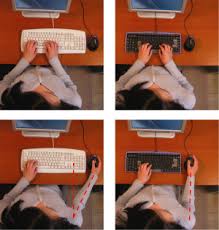

To learn more how to fix text neck with keyboard placement, you need to first understand the role of your keyboard in getting you a nerd neck.
Yes, it is indeed your beloved keyboard and its current positioning that has brought about the unwanted slide of the head in a forward direction.
Nonetheless, it can be fixed. All you need to do is place your keyboard just where it shall not hurt your cervical spine. So why waste any further time – let’s get on with it:
Contents of “How to Fix Text Neck by Keyboard Placement” Article:
1) How does Wrong Keyboard Placement cause Text Neck?
- The Role of Keyboard Placement
- The Mechanics of Text Neck
- Scientific Backing
- My Opinion
2) Can You Really Get Rid of Your Keyboard?
- The Reality Check
- The Necessary Evil
- Embrace the Inevitable
3) How to Fix Text Neck by Learning Correct Keyboard Placement?
- Position Your Keyboard at Elbow Height
- Keep the Keyboard Close
- Adjust the Keyboard Tilt
- Use a Keyboard Tray
- Break the Habit with Regular Adjustments
4) FAQs on Fixing Text Neck by Correct Keyboard Placement
5) Conclusion
How does Wrong Keyboard Placement cause Text Neck?
Text neck is a modern-day condition that has become increasingly common due to the extensive use of digital devices.
It is characterized by a forward head posture, leading to strain on the neck and upper back muscles.
One often overlooked contributor to this issue is the improper placement of your keyboard.
The Role of Keyboard Placement
When your keyboard is positioned too low or too far away from your body, it encourages a slouched posture.
You might find yourself hunching forward, dropping your head, and rounding your shoulders as you reach for the keys.
This posture, repeated over time, can lead to the development of text neck.
The Mechanics of Text Neck
The head weighs about 10-12 pounds when in a neutral position. However, as you tilt your head forward, the pressure on your neck increases dramatically.
According to a study published in Surgical Technology International, a 15-degree tilt can increase the effective weight on the cervical spine to 27 pounds, and at a 60-degree tilt, this pressure can rise to 60 pounds.
This excessive load on the neck muscles, tendons, and ligaments can cause pain, stiffness, and long-term damage.
Scientific Backing
A study in the Journal of Physical Therapy Science highlighted that improper ergonomic setups, including incorrect keyboard placement, contribute significantly to the development of forward head posture and text neck.
The study recommends maintaining a neutral spine position, which includes proper keyboard alignment, to reduce the risk of these conditions.
My Opinion
Incorrect keyboard placement can subtly yet significantly contribute to text neck.
Ensuring that your keyboard is at the correct height and distance can help maintain proper posture, reducing the strain on your neck and preventing the onset of this modern-day ailment.
Can You Really Get Rid of Your Keyboard?
There I was, hunched over my keyboard, rubbing my neck for the umpteenth time that day, when the thought hit me like a lightning bolt—could I just get rid of this keyboard altogether?
Imagine the freedom, the liberation from text neck, the ability to stand tall and proud once again. My neck would no longer feel like it was supporting the weight of the world.
It was a tantalizing dream, but alas, dreams and reality often clash in the most inconvenient ways.
The Reality Check
As much as I fantasized about kicking my keyboard to the curb, a sobering realization set in.
My keyboard, that sneaky little device, was my bread and butter. It was the tool that kept the lights on, the fridge stocked, and my Netflix subscription paid.
How could I possibly break up with something that was so vital to my livelihood?
It is like trying to ditch your umbrella in a rainstorm—it just doesn’t make sense, even if it does sometimes poke you in the eye.
The Necessary Evil
So, there I was, staring down at the keyboard that I both loved and loathed.
Sure, it was causing me a fair bit of grief in the neck department, but it was also the reason I could afford to keep buying those fancy ergonomic chairs that promised to fix everything (spoiler alert: they did not).
The truth is, as much as we might want to escape the clutches of our keyboards, they’re here to stay. They are our silent partners in the quest for making a living, one keystroke at a time.
Embrace the Inevitable
So, can you really get rid of your keyboard?
Not unless you have figured out how to make money by meditating in the mountains.
For the rest of us, we will just have to find a way to coexist with our keyboards, neck pain and all.
Now, if you will excuse me, I need to type out another few hundred words—and maybe book a massage.
How to Fix Text Neck by Learning Correct Keyboard Placement?
Text neck is a modern-day menace, a consequence of our love affair with technology.
But what if I told you that one of the simplest ways to fix text neck is by correcting your keyboard placement?
That’s right!
By making a few adjustments to how and where you use your keyboard, you can significantly reduce the strain on your neck and get back to feeling comfortable at your desk.
You also need to learn how to choose a keyboard that corrects poor neck posture.
Here are a few points that you need to keep in mind while trying to correct your nerd neck while working on your laptop/desktop using a keyboard:
Position Your Keyboard at Elbow Height
The first step to fixing text neck is ensuring that your keyboard is at the right height.
Your keyboard should be positioned at or just below elbow height, allowing your arms to rest comfortably at your sides.
According to a study published in Applied Ergonomics, incorrect keyboard height can lead to poor posture, which in turn contributes to neck strain.
When your keyboard is too high or too low, your shoulders tend to tense up, and your neck follows suit, leading to the dreaded text neck.
Keep the Keyboard Close
Distance matters!
If your keyboard is too far away, you will find yourself leaning forward, craning your neck, and adopting a posture that’s just asking for trouble.
A study in the Journal of Physical Therapy Science recommends keeping your keyboard close enough that your elbows stay comfortably by your sides.
This minimizes the need to lean forward, helping maintain a neutral spine and reducing neck strain.
Adjust the Keyboard Tilt
Believe it or not, the angle of your keyboard can also impact your neck posture.
An ideal keyboard tilt allows your wrists to stay straight, preventing unnecessary strain on your forearms, shoulders, and neck.
Research in the International Journal of Industrial Ergonomics suggests that a slight negative tilt—where the front of the keyboard is slightly lower than the back—can help maintain a more ergonomic posture, reducing the risk of developing text neck.
Use a Keyboard Tray
A keyboard tray can be a game-changer for your posture.
These trays allow you to adjust the height and angle of your keyboard with ease, ensuring that it is always in the most ergonomic position.
A study in Work: A Journal of Prevention, Assessment & Rehabilitation found that using a keyboard tray significantly improved participants’ posture and reduced the incidence of neck pain.
Break the Habit with Regular Adjustments
Even with perfect keyboard placement, staying in one position for too long can contribute to text neck.
Regularly adjust your keyboard’s position and take short breaks to stretch your neck (neck stretches) and shoulders (shoulder stretches).
A study published in the Journal of Occupational Health Psychology found that frequent breaks and posture adjustments are crucial in preventing musculoskeletal disorders, including text neck.
FAQs on Fixing Text Neck by Correct Keyboard Placement
Q1: How does keyboard placement influence the development of text neck?
A1: Improper keyboard placement can lead to forward head posture, commonly known as “text neck.” When the keyboard is positioned too high or too low, it forces individuals to tilt their heads forward or backward, increasing strain on the neck muscles and potentially leading to discomfort or injury.
Q2: What is the optimal height for keyboard placement to prevent text neck?
A2: The keyboard should be positioned at or slightly below elbow height. This alignment allows the forearms to remain parallel to the ground, reducing the need to tilt the head forward or backward, thereby minimizing neck strain.
Q3: How far should the keyboard be from the body to maintain proper posture?
A3: The keyboard should be placed directly in front of you, close enough that your elbows remain close to your body and your hands can reach the keys comfortably without extending your arms forward. This setup helps maintain a neutral neck position and reduces the risk of developing text neck.
Q4: Does the angle of the keyboard affect neck posture?
A4: Yes, the angle of the keyboard can influence neck posture. A slight negative tilt, where the back of the keyboard is lower than the front, can help keep the wrists in a neutral position and reduce the tendency to lean forward, thereby alleviating neck strain.
Q5: How can ergonomic keyboards assist in preventing text neck?
A5: Ergonomic keyboards are designed to promote a more natural hand and wrist position, which can indirectly reduce neck strain. Features such as split key layouts and adjustable tilts allow users to maintain a more neutral posture, decreasing the likelihood of developing text neck.
Q6: Are there additional ergonomic practices to complement proper keyboard placement?
A6: Yes, incorporating regular breaks to stand, stretch, and move around can alleviate muscle tension and promote better posture. Additionally, ensuring that the monitor is at eye level and maintaining a neutral spine position while seated can further reduce the risk of developing text neck.
Takeaway
In the battle against text neck, your keyboard can be both the culprit and the hero.
As explored in the article, incorrect keyboard placement subtly but significantly contributes to the development of text neck, a condition that can lead to chronic pain and discomfort.
However, with a few mindful adjustments, your keyboard can also be the key to preventing and even reversing this modern-day ailment.
As per bestforwardheadposturefix.com research, “By positioning your keyboard at elbow height, keeping it close to your body, adjusting its tilt, and using a keyboard tray, you can maintain a neutral spine position and fix forward head posture fast.
Regular adjustments and breaks further ensure that your posture remains healthy, even during long work hours.
Ultimately, while it might be tempting to dream of a life without keyboards, they are integral to our daily lives and livelihoods.
The solution is not to get rid of your keyboard but to use it wisely.
By learning and applying these ergonomic principles, you can work comfortably and efficiently, keeping text neck at bay.
References:

